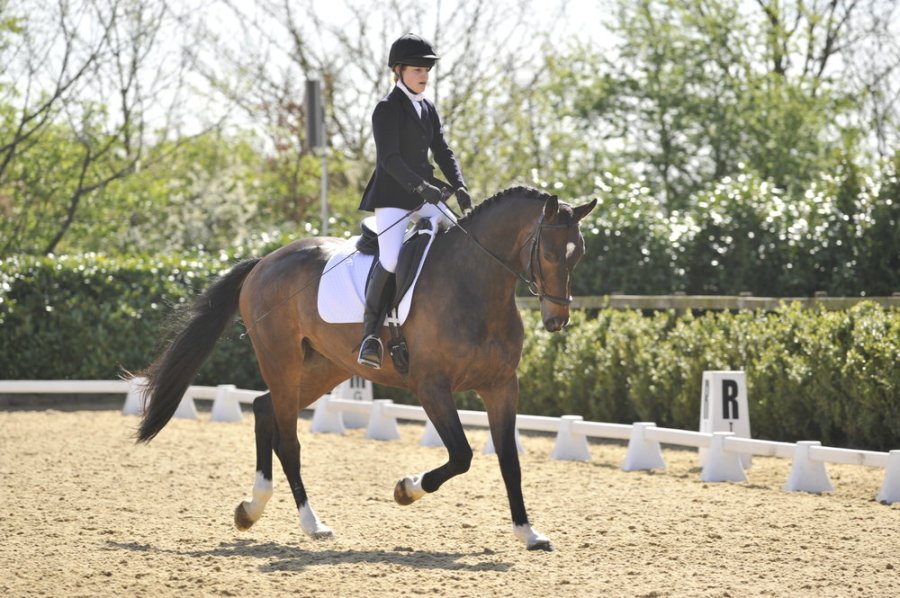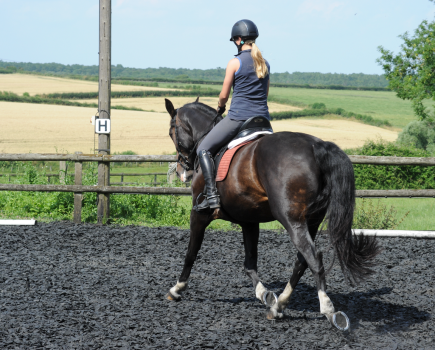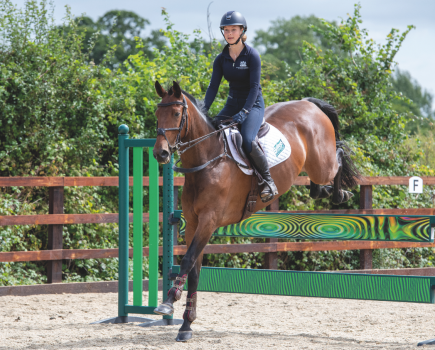How aware are you of your position in the saddle? Your riding position has a massive impact on your horse. Whether you take part in dressage, showjumping, eventing or hacking, the way you sit in the saddle has a huge influence on multiple aspects, including your horse’s own posture, their core strength, hoof and back health. It’s essential to refine rider position in order to improve your horse’s carriage and correct asymmetries, and by working on their posture you will also improve their welfare and reduce the risk of injury.
The effort a horse puts in to carrying a rider is easily forgotten, but your horse can feel a single fly landing on their body, so they’re certainly aware of you sitting on their back. Therefore, how straight and central you sit, where your hands are, your stirrup position, and even the way you tilt your head, will all have an impact on your horse’s way of going.
The first thing to do is check your rider position. “After noticing an imbalance and recognising we need to put it right, it’s too easy to just say we’re crooked — we need to figure out exactly what crooked means,” says performance analyst Dr Russell MacKechnie-Guire, who manages Centaur Biomechanics and works with leading riders through the World Class Programme.
How to check rider position
When you’re on your riding a horse it can be hard to tell whether or not you’re sitting correctly. Using a schooling field or arena with mirrors is a useful way to check rider position, as is being filmed so that you can watch it back. Russell recommends doing the following checks, for which you’ll need assistance from a friend on the ground. Be sure to wear fitted riding clothes rather than baggy ones so that any faults are easier to spot.
How straight are you sitting?
“We’re interested in how straight the saddle is, and how straight you are to the saddle with your upper body and pelvis,” explains Russell. “To check your position, ask a friend to take photos or videos of you riding from behind and the side so you can analyse your position.”
Key things to look for:
- Your ear, shoulder, hip and ankle should all be in line.
- Be aware that different paces will emphasise crookedness and you may ride differently on each rein, so check them both.
- Address the position of your seat first, and then the saddle before looking at your upper body.
- The aim is for you to be sitting in the centre of your horse in order to facilitate lateral work.
- If your position is off centre, your horse will be off too — this has implications for jumping, dressage and, in fact, ridden work in general.
- Make sure that you have your saddle checked regularly by a professional fitter to try to reduce any displacement you may find.
Rider position: check your spine
“Your spine should be neutral — not too far forward or back,” says Russell. “The front of your pelvis should be tipped upwards and your seat must be in contact with the saddle with your shoulders back.”
Rider position: arms
“Keep your arms against your sides, you don’t want to be riding around with ‘chicken wings’,” states Russell. “There should be a slight bend at your elbow and this should be even so that both arms are level with each other.”
Rider hands
Your hands should be in line and not asymmetrical. “Make sure your thumbs are on top, rather than tipped over — not like you’re ‘pushing a pram’,” says Russell. “Keep your hands held forward instead of pulling them back into your body.”
Knee position
In a correct rider position, your knees should be against saddle and not sticking out.
Rider foot position
One of the first things you’re told when learning to ride is “Heels down, toes up” and getting this right goes a long way to helping you achieve a secure seat. Your feet shouldn’t be too far forward or too far back in the stirrup — a good guide is to place the iron under the ball of each foot.
“Feet shouldn’t stick out from your horse’s side; toes should point forward,” says Russell. “Check your stirrups are the same length. Making one of your stirrups longer is not a cure for asymmetry; it actually increases loading on the limbs and can affect your spine.”
Exercises to improve rider position
1 Ride without stirrups
Taking away your stirrups will help you to rebalance your position naturally. To improve rider position, do five minutes each day without stirrups (if you feel safe to do so), or ride without stirrups on the lunge. Taking away the stability points (ie your reins and stirrups) makes you more aware of your seat.
How to ride it:
- The first area to work on is your pelvis. Go large in walk on the left rein.
- Imagine your pelvis as a bowl of water. Where is the water tipping? Think about drawing the front of your pelvis up and tucking your tailbone and seat beneath you. This also helps to straighten your back.
- Another way to visualise it is “don’t sit like a duck, sit like a Whippet”. Think about the difference in these animals’ posture (specifically their backs) and you’ll understand!
- Now ride a 20m circle at either end of the arena, then turn up the centre line, get yourself straight and close your eyes.
- Closing your eyes helps you to feel your horse and removes distractions, so you’re more aware of their movement. Have someone watch you and tell you when to reopen them.
- Where do you end up? Have you stayed straight or veered off to one side?
- Repeat on the other rein and in trot. Sit deeper in the saddle so you don’t bounce.
2 Take away your reins
Riding with your reins in one hand is another great exercise to get you focused and riding from your seat and leg rather than the rein. Start by riding this exercise with your stirrups, but you can take them away if you feel confident enough.
How to ride it:
- In walk or trot on a 20m circle, put your reins in one hand and lift your ‘spare’ hand straight up into the air.
- Now hold your arm straight out in front of you.
- Make sure you keep your head up and your eyes looking straight in front.
- Take your reins back while you change the rein, then repeat.
3 Use your seat rather than reins
The goal is to control your horse with your seat and not your reins. Practising this in your transitions is key. Try riding on the inside track doing trot-walk-trot transitions. This will help you to feel where your horse wants to put their quarters. Do they wobble at all? Are they trying to grab the inside rail?
How to ride it:
- Go large in walk around the arena on the inside track. At various points or markers ask your horse to move up to trot and then back down to walk.
- Continue to ask your horse to move between walk and trot and focus on using your seat.
- Keep thinking about your position, pelvis titled up, eyes looking up and ahead.
- Swing through your seat to increase the hindleg action.
- Take notice of the differences that making these changes has to the quality of your horse’s transitions.
4 Move your head
“Your eyes are always trying to balance you, so another good exercise to try if you’re crooked is moving your head,” explains Russell. Take back your stirrups for this exercise.
How to ride it:
- On a 20m circle, feel the pressure in your stirrups. Which side has more pressure?
- On a 20m circle in trot, visualise how much pressure you put in your stirrups.
- Turn your head to the right. What changes? Now look across to your left.
- You should notice that moving your head to look one way puts more weight into your opposite stirrup.









